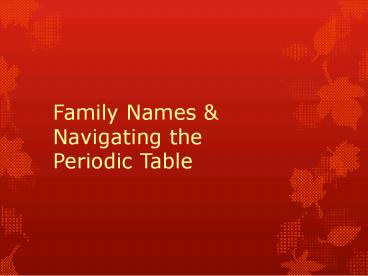Family Names - PowerPoint PPT Presentation
Title:
Family Names
Description:
Family Names & Navigating the Periodic Table Part 1 Metals, Nonmetals & Metalloids Highlight this stair-step line to separate the metals from the non-metals ... – PowerPoint PPT presentation
Number of Views:86
Avg rating:3.0/5.0
Title: Family Names
1
Family Names Navigating the Periodic Table
2
Part 1
- Metals, Nonmetals Metalloids
3
- Highlight this stair-step line to separate the
metals from the non-metals
4
- Everything above and to the right is a nonmetal
5
Nonmetals
- Tend to gain electrons
- Form negative ions (-)
- Do not conduct electricity
- Are brittle (unmalleable)
6
- Everything below and to the left is a metal
7
Metals
- Tend to lose electrons
- Form positive ions ()
- Are malleable and ductile
- Conduct electricity
8
Metalloids
- Mark these with an
- B, Si, Ge, As, Sb, Te, Po
- These sometimes act like a metal, sometimes like
a nonmetal.
9
Part II
- Families in the Periodic table
10
Important definitionValence Electrons
- Valence electrons are the number of electrons in
the outer-most energy level (outer-most shell) of
an atom - They are completely responsible for how an
element reacts with other elements.
11
Elements are arranged in Families Groups or
Columns (i.e up and down)
- Families have similar properties
- Usually have the same number of valence electrons
- React similarly
12
Alkali Metals
- The first column
- One valence electron
- Explosively reactive
- Na, K, Rb, Cs, Fr
- Form bases (alkaline) solutions
13
Alkaline Earth Metals
- Are the second column
- Have two valence electrons
- Stable in air, but
- React quickly with a little energy
- Be, Mg, Ca, Sr, Ba, Ra
- Make up many minerals
14
Transition Metals are everything in Columns 3 - 12
- Tend to be what we think of when we think metals
- Cr Chrome, Au Gold, Fe Iron, Cu Copper
- Have no rule for valence electrons
15
Noble Gases
- are the very last column
- Have eight valence electrons except Helium (He)
has 2 - Are very stable
- Do not react with anything (usually)
16
Halogens
- Column 17 next to noble gases
- Have seven valence electrons
- Extremely reactive
- F, Cl, Br, I, At
- Often used to kill bacteria
- (think choline bleach, bromine in spas or pools)
17
- 13Boron Family, 3 valence electrons
- 14 Carbon Family, 4 valence electrons
- 15Nitrogen Family, 5 valence electrons
- 16 Oxygen Family, 6 valence electrons
18
- The Two rows separated at the bottom are the Rare
Earth Metals and are referred to by the first
element in their row
19
- The First Row are the Lanthanides,
- After La, Lanthanum
- The Second Row are the Actinides, after Ac,
Actinium
20
- Everything bigger than Uranium (92) is
human-made. - They are created in a laboratory rather than
discovered. - They are all radioactive and most only stay
together for less than a second.































